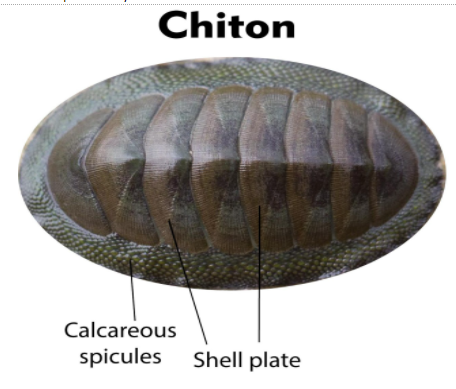
Which class shows 8 dorsal plates of the shell?
A)Amphineura
B)Monoplacophora
C)Scaphopoda
D)Cephalopoda
Answer
469.8k+ views
Hint: It belongs to the phylum Mollusca. The body is elongated and has bilateral symmetry. It is a Marine Mollusca and has 7 or 8 overlapping plates on the dorsal surface of the shell.
Complete answer:
-Amphineura commonly known as sea cradles or chitons and its literal meaning is many plate bearers. They are marine. They are found from shallow water to deep ocean.
-At the front and back edges, the cells of Amphineura consist of eight overlapping dorsal plates. These plates are joined together on the outer margin and move internally to the girdle. The girdle is the thick part of the mantle.
-Girdles may have scales, spines or bristles; their plates are flexible, which helps them for locomotion. Shells also provide protection to the animals.
-The shells of animals are arranged in such a way that it has Chitons to roll into a protective ball when they are dislodged to an uneven surface.
Additional Information: Monoplacophora- they are primitive Mollusca. They are found in the deep sea. They bear only one dorsal plate.
Scaphopoda- they are shelled marine Mollusca. They have a tubular shell that is open at both ends.
Cephalopoda- it includes animals such as octopus nautilus, Cuttlefish. Their shell is internal or reduced. In nautilus the shell is external and in octopus, the cell is totally absent.
So, the correct answer is, "Amphineura".
Note: -Amphineura has tentacles or cephalic eyes. Their mouth is anterior with a radula. They feed on algae.
-Radula helps in scrapping the algae from the hard surfaces.
-Some species may also feed on small crustaceans.

Complete answer:
-Amphineura commonly known as sea cradles or chitons and its literal meaning is many plate bearers. They are marine. They are found from shallow water to deep ocean.
-At the front and back edges, the cells of Amphineura consist of eight overlapping dorsal plates. These plates are joined together on the outer margin and move internally to the girdle. The girdle is the thick part of the mantle.
-Girdles may have scales, spines or bristles; their plates are flexible, which helps them for locomotion. Shells also provide protection to the animals.
-The shells of animals are arranged in such a way that it has Chitons to roll into a protective ball when they are dislodged to an uneven surface.
Additional Information: Monoplacophora- they are primitive Mollusca. They are found in the deep sea. They bear only one dorsal plate.
Scaphopoda- they are shelled marine Mollusca. They have a tubular shell that is open at both ends.
Cephalopoda- it includes animals such as octopus nautilus, Cuttlefish. Their shell is internal or reduced. In nautilus the shell is external and in octopus, the cell is totally absent.
So, the correct answer is, "Amphineura".
Note: -Amphineura has tentacles or cephalic eyes. Their mouth is anterior with a radula. They feed on algae.
-Radula helps in scrapping the algae from the hard surfaces.
-Some species may also feed on small crustaceans.

Recently Updated Pages
Can anyone list 10 advantages and disadvantages of friction

What are the Components of Financial System?

How do you arrange NH4 + BF3 H2O C2H2 in increasing class 11 chemistry CBSE

Is H mCT and q mCT the same thing If so which is more class 11 chemistry CBSE

What are the possible quantum number for the last outermost class 11 chemistry CBSE

Is C2 paramagnetic or diamagnetic class 11 chemistry CBSE

Trending doubts
10 examples of friction in our daily life

The correct order of melting point of 14th group elements class 11 chemistry CBSE

Difference Between Prokaryotic Cells and Eukaryotic Cells

One Metric ton is equal to kg A 10000 B 1000 C 100 class 11 physics CBSE

What is the specific heat capacity of ice water and class 11 physics CBSE

State and prove Bernoullis theorem class 11 physics CBSE




